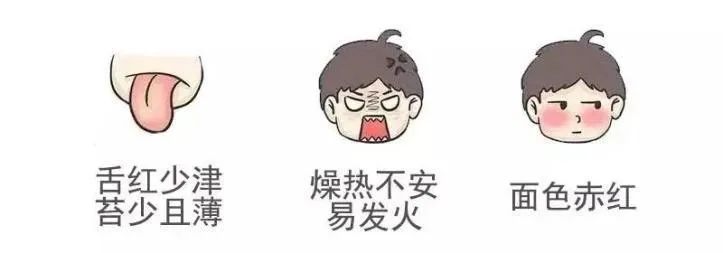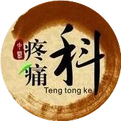Generally speaking, a red tongue with no coating, or even a mirror-like tongue, is a manifestation of yin deficiency and fluid deficiency. According to “Diagnosis of Tongue Quality in Traditional Chinese Medicine”, a tongue that is dark red and moist indicates a condition of yin deficiency with excess heat in internal injuries, often accompanied by phlegm-dampness; a red and dry tongue with little fluid in internal injuries indicates either excess heat due to yin deficiency or hyperactivity of heart fire. A dark and shiny tongue suggests severe deficiency of stomach and kidney yin. However, in clinical diagnosis and treatment, a comprehensive consideration should be made. Otherwise, one may fall into the trap of confusing deficiency with excess.

An 80-year-old woman with a history of coronary heart disease and chronic heart failure was hospitalized for over two months in a certain hospital, undergoing various traditional Chinese and Western medicines, yet her condition worsened. The patient was emaciated, mentally clear but in poor spirits, exhibited shortness of breath, and was unable to move independently. She had severe edema in both lower limbs, with pitting edema upon pressure; poor appetite, vomiting immediately after eating, abdominal distension like a drum, and had not defecated for seven days despite several enemas, now requiring a gastric tube for decompression. The tongue was dark red with no coating, dry with little fluid, and shiny like a mirror. The pulse was slippery and firm, with weak pressure. The diagnosis indicated a deficiency of yang qi, water retention obstructing the heart, and failure of lung qi to disperse, leading to stagnation in the intestines. The main pathological mechanism was the deficiency of yang qi, which failed to transform water, causing it to obstruct the heart and lungs above and the intestines and muscles below, resulting in blocked bowel movements. The previous treatments used by other doctors were all nourishing and regulating, but overly focused on nourishing yin and dampness, and the medication was cautious due to the patient’s advanced age and frailty, aiming for a treatment without excess. The treatment should focus on warming yang, tonifying qi, promoting water metabolism, and unblocking the intestines to eliminate turbidity. The prescription included: Ren Shen (Ginseng) 10g (separately decocted), Fu Zi (Aconite) 10g (pre-decocted), Zhu Ling (Polyporus) and Fu Ling (Poria) each 15g, Bai Zhu (White Atractylodes) 10g, Ze Xie (Alisma) 10g, Ting Li Zi (Descurainia) 15g, Gui Zhi (Cinnamon Twig) 10g, Gua Lou (Trichosanthes) 10g, Yu Jin (Curcuma) 10g, Hou Po (Magnolia Bark) 30g, Zhi Shi (Bitter Orange) 10g, Da Huang (Rhubarb) 10g, and finally Gan Cao (Licorice) 6g, Chao Xing Ren (Fried Apricot Kernel) 10g, and 6 dates, decocted into a concentrated solution, administered multiple times in small amounts via the gastric tube.
The formula was based on Shen Fu Decoction, Wu Ling San, and Ting Li Da Zao Xie Fei Tang to tonify qi, warm yang, promote water metabolism, and transform phlegm, thus restoring yang qi, reducing water retention, and enhancing the function of the internal organs. Additionally, Hou Po San was used to directly expel intestinal stagnation. Upon re-examination the next day, the patient’s shortness of breath significantly decreased, edema visibly reduced, and she had seven bowel movements of foul-smelling, thin, and sticky stools, with abdominal distension alleviated. The prescription was adjusted by reducing Hou Po to 10g, changing Da Huang to 5g prepared with wine, and decocting with the other herbs, followed by two more doses. The patient’s abdominal distension completely resolved, bowel movements returned to daily, shortness of breath stabilized, she could lie flat, turn over independently, and lower limb edema significantly decreased, allowing her to consume small amounts of food without nausea or vomiting. The tongue quality changed to light red, moist, with a thin white coating, indicating a gradual recovery of yang qi, reduction of water retention, and normal distribution of fluids. The prescription was further modified by removing Zhi Shi, Hou Po, and Da Huang, adding Mai Dong (Ophiopogon) 10g and Wu Wei Zi (Schisandra) 15g to nourish yin and support yang, restoring health. In total, over 20 doses were adjusted from the previous formula, and the patient was able to get out of bed and care for herself.
In general, a red tongue with no coating and dryness is a manifestation of yin deficiency and fluid deficiency. However, tongue diagnosis is only one part of TCM diagnosis, and it should be considered in the context of the overall symptoms. Yin fluids refer to bodily fluids, which require yang qi to vaporize and circulate normally. In this patient, the yang qi was severely deficient, and the bodily fluids were not following their normal pathways, leading to obstruction in the heart, lungs, intestines, and muscles. A red tongue with no coating does not merely indicate a deficiency of yin fluids, but rather a failure of yang to transform yin, lacking the power to vaporize bodily fluids and causing them to overflow. Therefore, merely nourishing yin is ineffective; it is essential to warm yang and transform fluids to restore normal distribution of bodily fluids, which will naturally lead to the appearance of tongue coating.
Yourlikes are our motivation for progress!↘↘↘

